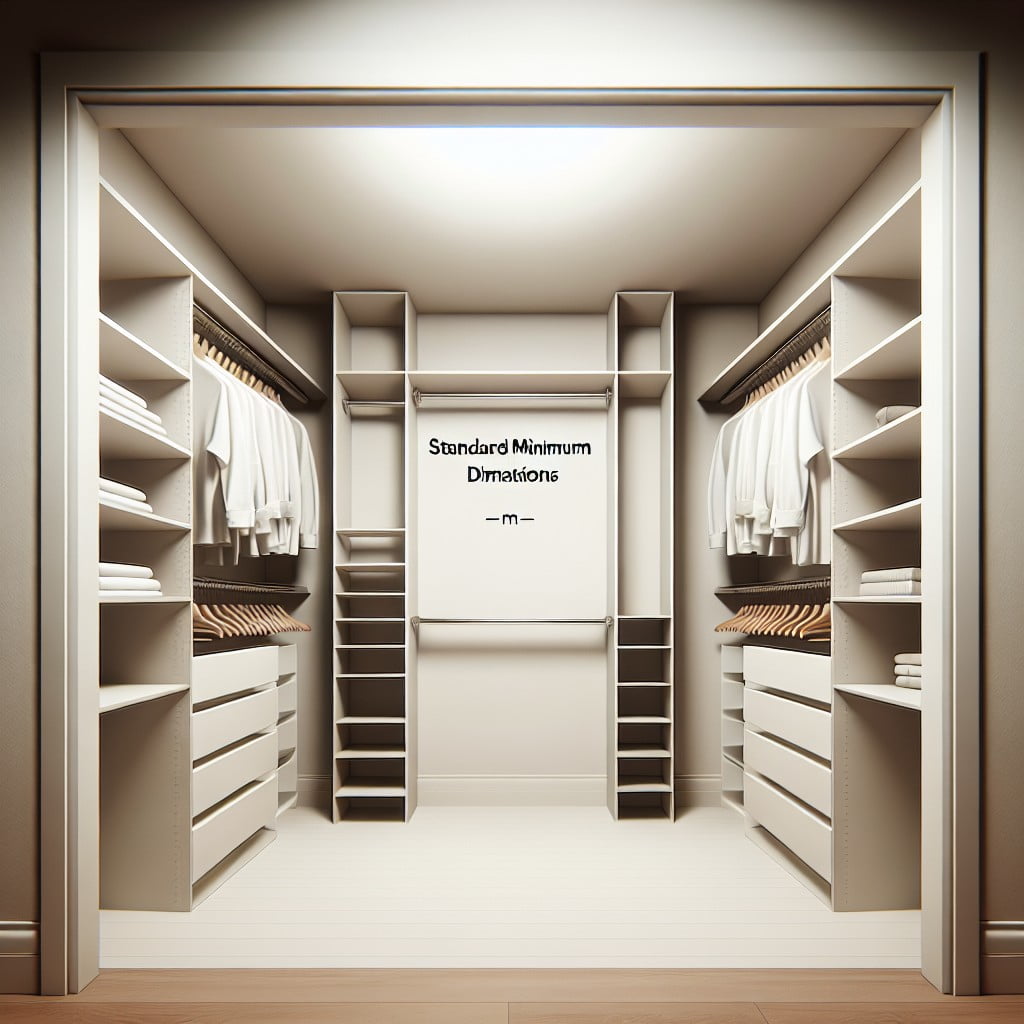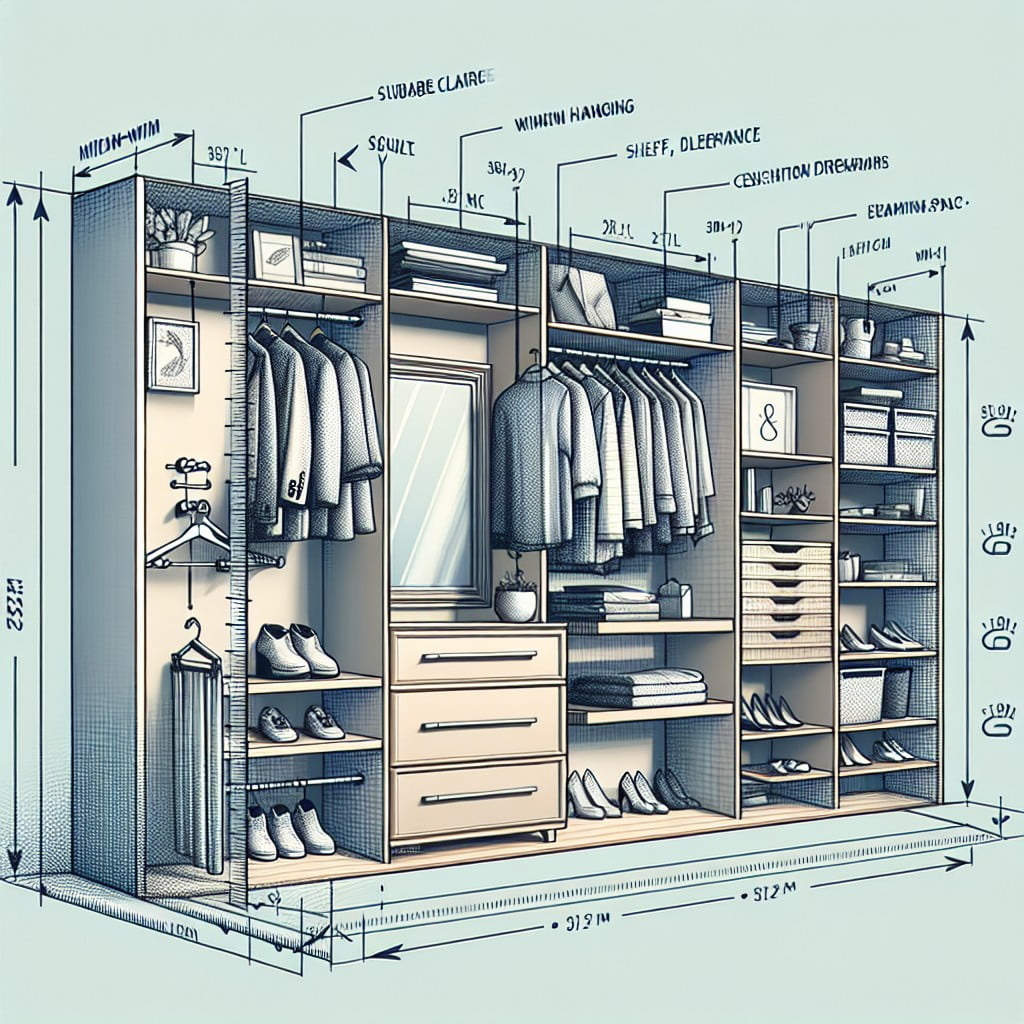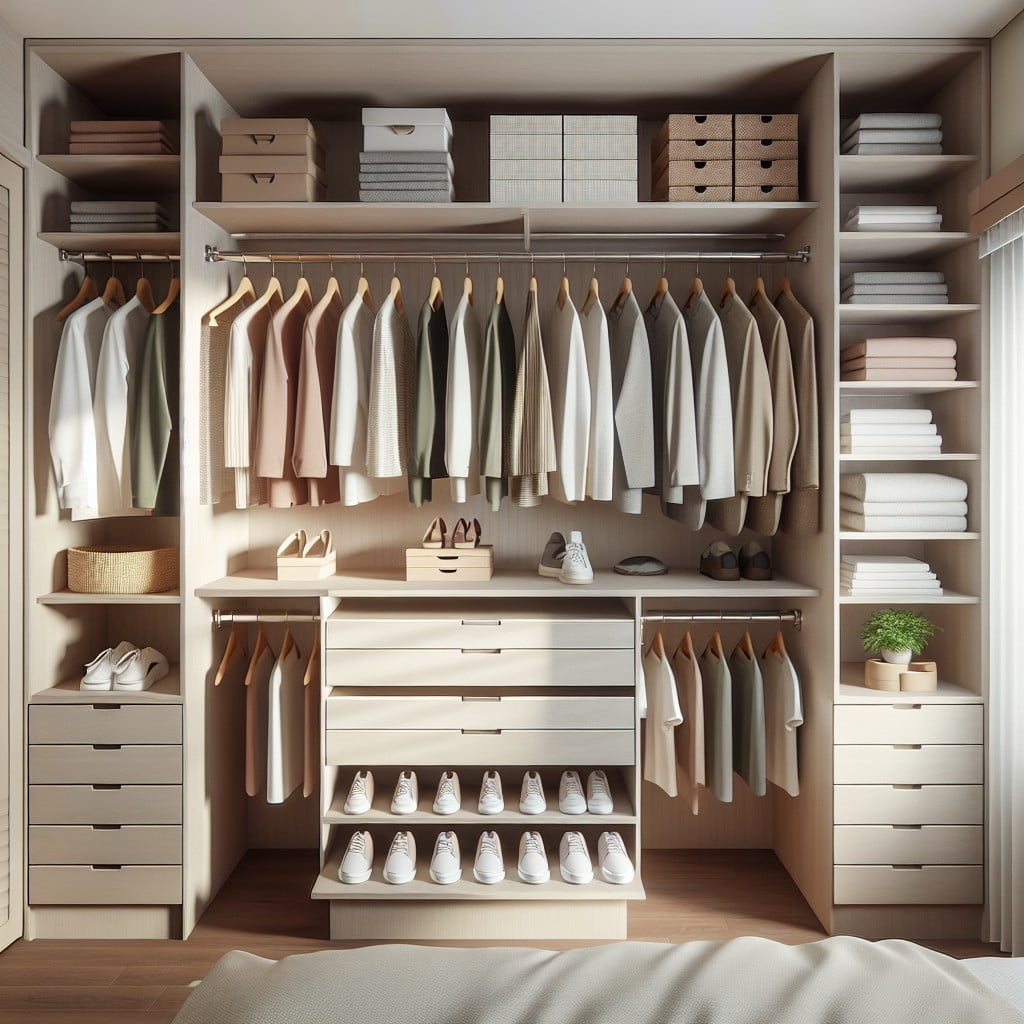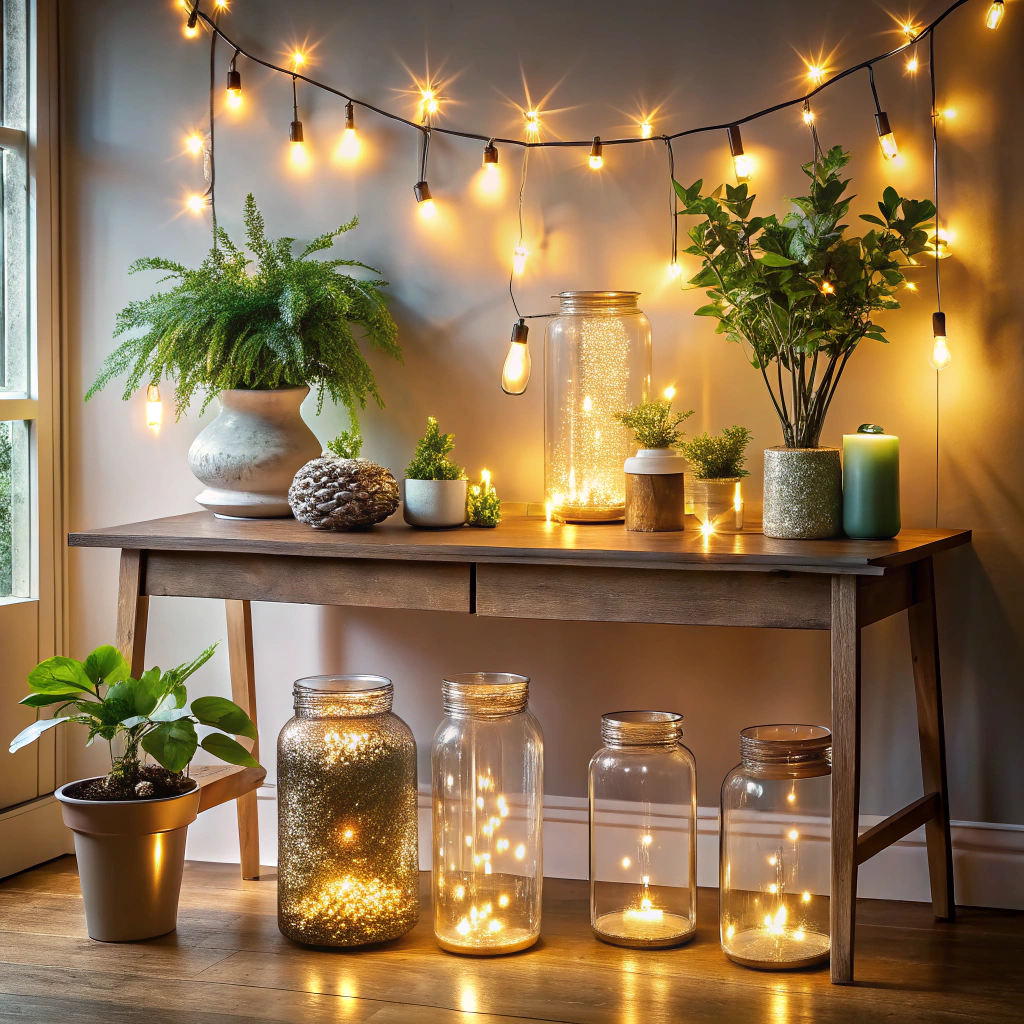Last updated on
Understanding the minimum width for a walk-in closet is essential because it affects not only the function and convenience of the closet but also the overall aesthetic appeal of your home.
Key takeaways:
- Minimal width for walk-in closet is 4×4 feet
- Width of 6-8 feet recommended for comfortable space
- Consider depth of 24 inches for hanging clothes
- Standard height is 84 inches with adjustable options
- Factors impacting width include clothing collection, access, built-ins, lighting, and personal preference
Standard Walk-in Closet Dimensions

When planning a walk-in closet, it’s essential to know that there’s no one-size-fits-all answer. However, standard dimensions serve as a reliable starting point. Typically, a comfortable width for a walk-in closet is at least 6 to 8 feet. This allows for 3 feet of space for hanging items on either side and a clear walking area down the middle.
The depth of a closet is also critical, with 24 inches deemed practical to accommodate hanging clothes without them protruding into the walking space. An ideal length for hanging sections on one wall is 4 feet; this caters well to a variety of garments.
Height considerations can vary but maintaining a standard 84 inches to the rod provides ample space for longer items like dresses and coats. Adjustments can be made for double-hang sections for shirts and pants, where 42 inches between rods maximizes vertical storage.
These dimensions ensure comfort, convenience, and a touch of luxury in the design of any walk-in closet. They provide a framework for an organized and accessible wardrobe area, adapting to the specific needs and styles of the user.
Minimum Dimension Requirements

Understanding the minimum dimension requirements for a walk-in closet ensures both functionality and comfort. At the very least, a walk-in closet should be 4 feet wide by 4 feet deep. With this dimension, there’s enough space to hang clothing along one wall and provide a clear path for walking.
To comfortably fit clothing as well as a person inside, aim for a width of 6 to 8 feet. This allows for hanging spaces on both sides. Height is another consideration; a standard closet is usually 84 inches tall, which accommodates two tiers of hanging rods.
When planning your closet, remember to account for the width of the closet’s door. If a swinging door is used, the minimum recommended width should be increased by the door’s width to maintain accessibility. For ease of use and efficient storage, factor in shelves, drawers, and other organizational features, each typically requiring at least 12 inches of depth.
For those who prefer more breathing room or have a more extensive wardrobe, a width of 10 to 12 feet can offer a luxurious amount of space and more flexibility in terms of design and organization options.
In all cases, it’s important to measure the items you plan to store and consider the closet’s layout to ensure your needs are met within the space constraints.
Factors Influencing Minimum Width

The size of the clothing collection significantly affects the necessary width. More garments typically require additional hanging space and shelving, increasing the closet’s minimum width.
Access and movement within the closet are crucial for comfort and functionality. Ideally, there should be enough room to move freely, try on clothes, and view items without constraint, which may push the width beyond the minimum when multiple users are considered.
Built-ins and organizers also play a role. The inclusion of drawers, shelves, and specialty racks demands careful planning to ensure these features fit comfortably without overcrowding the space.
Lighting and ventilation might not be top of mind but are essential for preserving clothes and enhancing the closet experience. Ensuring proper airflow and lighting can impact the width to accommodate these systems.
Personal preference can vary. Some may prioritize ample floor space for dressing, requiring a wider design, while others might prefer maximizing storage by reducing the walkway area.
Ultimately, the minimum width should accommodate these factors to ensure the walk-in closet is both practical and pleasurable to use.
Single-Sided Walk-in Closet

For a single-sided walk-in closet, the main focus is on one wall where clothing and items are stored. This design is optimal when dealing with limited space. Typically, the minimum width recommended is 4 to 5 feet. This allows enough room for hanging garments without the risk of them being brushed or crumpled when passing by.
In such a configuration, the opposite wall might be used for slimmer items like ties, belts, and accessories, or left free to enhance the feeling of spaciousness. Critical to this layout is efficient use of vertical space—shelving up high for less frequently used items can free up lower areas for easier access.
Here are some pivotal points to consider:
- Space for Movement: Ensure at least 24 inches of clear space in the center of the closet to move comfortably.
- Hanging Rod Positioning: Install the hanging rod at least 12 inches from the back wall for easy access to hangers and clothing.
- Accessory Storage: Consider slim-profile shelving or hooks on the back of the door for additional storage.
- Custom Organization: Use custom-designed organizers tailored to specific wardrobe needs to maximize space efficiency.
- Lighting Considerations: Good lighting is essential. Aim for a well-lit space to avoid shadows and dark corners, making for a more inviting atmosphere and easier item selection.
Double-Sided Walk-in Closet
For a double-sided walk-in closet, where clothing and accessories are stored on both sides, the space needs to be more generous. Ideally, the width should be about 7 feet to allow for comfortable movement between the two facing storage areas. This width accommodates hanging space on both sides while ensuring there’s enough room in the center for someone to walk through without brushing against clothes.
Key points to consider for a double-sided walk-in:
- Ample Space: With around 24 inches needed for hanging clothes on each side, plus the recommended 36 inches of clearance for the walkway, the sum comes to 84 inches, or 7 feet. This width ensures you can browse and access items with ease.
- Versatile Storage: Utilize varying heights for rods and shelves to make the most of vertical space, keeping off-season or less frequently used items higher up.
- Adequate Lighting: Ensure the closet is well-lit, with strategically placed fixtures to avoid shadows and dark corners for optimal visibility and accessibility.
- Mirrors and Accessories: Incorporate mirrors on doors or walls to visually expand the space and add functionality. Consider built-in drawers or tilt-out laundry hampers to conserve space.
By adhering to these dimensions and incorporating smart design features, the closet will not only be practical but also a pleasure to use.
Storage Solutions for Narrow Walk-in Closets
Maximizing space in a narrow walk-in closet requires both creativity and strategic planning. By choosing the right storage solutions, even the most slender of closets can become highly organized and functional.
Here are a few ideas:
- Vertical Storage: Utilize the height of the closet with tall shelving units and stackable drawers that draw the eye upward and keep floors clear.
- Pull-Out Baskets: Incorporate pull-out baskets or bins for easy access to items stored lower in the closet without disrupting the entire organization.
- Hooks and Pegs: Place hooks or pegs on unused wall space or the back of the closet door for hanging items such as scarves, belts, and jewelry.
- Slim Hangers: Select slim-profile hangers to maximize hanging space and maintain a neat, uniform look.
- Customizable Shelving: Install adjustable shelving that can be moved to accommodate various item sizes, allowing for a flexible arrangement.
- Overhead Storage: Make good use of the closet’s upper reaches with high shelves ideal for seasonal items and less frequently used belongings.
- Mirror Installation: Adding a mirror can visually expand the space and eliminate the need for a separate full-length mirror elsewhere in the room.
By thoughtfully selecting and arranging these storage elements, a narrow walk-in closet becomes an efficient and surprisingly spacious area.
Tips for Maximizing a Minimal Space
To optimize your closet’s functionality when dealing with constrained dimensions:
- Install a Customizable Shelving System: Adjustable shelves adapt to your evolving storage needs, allowing you to allocate space efficiently for various item sizes.
- Employ Multifunctional Hangers: Cascading or multi-tiered hangers save on rod space while keeping clothes accessible and organized.
- Incorporate Pull-out Baskets or Drawers: These provide easy access to items stored at the back, making full use of the closet’s depth.
- Add Over-the-Door Organizers: Make use of the often-overlooked space behind the door for additional storage options for smaller items or accessories.
- Use Vertical Space Wisely: Install hooks or pegs up the wall or on the back of the door to hang items like belts, hats, or scarves.
- Opt for Sliding Doors: Compared to traditional hinged doors, sliding doors require no swing space and can streamline access in tight quarters.
- Brighten with Strategic Lighting: Proper lighting makes it easier to find items and can create the illusion of a larger space.
- Declutter Regularly: Keep your closet space functional by periodically assessing and removing items that no longer serve your needs.
By focusing on these strategies, you can significantly enhance the utility and ease of use of even the most compact walk-in closet.
Building Codes and Regulations Impacting Closet Design
Adhering to building codes and regulations is a crucial step in closet design to ensure safety and compliance. Here are some points of consideration:
1. Local Building Codes: Always check with your local building department for specific requirements as they can vary by location.
2. Accessibility Requirements: Codes may specify minimum dimensions to accommodate people with disabilities. The Americans with Disabilities Act (ADA) sets forth guidelines which, while more common in public and commercial spaces, could influence residential design.
3. Egress Concerns: Some codes may treat large walk-in closets as habitable spaces, requiring adequate egress windows or doors in case of an emergency.
4. Ventilation: Proper air circulation must be maintained. Building codes could dictate the need for a ventilation system in your closet design to prevent mold and mildew.
5. Lighting and Electrical: Regulations may require specific types of lighting and outlets installation, including positioning and number, to meet safety standards.
6. Permits: Depending on the extent of your construction or renovation, obtaining the proper permits before beginning work is important to ensure compliance and avoid future legal or selling complications.
Understanding and incorporating these elements into your walk-in closet project early on can save time and additional costs, ensuring that your closet will be both functional and up to code.
Professional Insights On Closet Planning and Design
Engaging with a design professional can significantly enhance the functionality and aesthetic of your walk-in closet. Their expertise often results in a tailored solution that harmonizes with your lifestyle and storage needs. Here are some insights from design experts:
- Ergonomics First: Designers recommend leaving enough room for movement, with a focus on comfortable reach zones and avoiding overcrowding the space.
- Customization: Custom-built components can address specific storage needs while making the most of every inch.
- Lighting: Good lighting is essential. Professionals might suggest installing varied lighting options to create a bright, accessible closet environment.
- Ventilation: Adequate air flow is important in a closet to keep clothing fresh, something professionals will not overlook during planning.
- Flexibility: Adjustable shelving and modular components allow you to adapt your closet layout as your wardrobe changes over time.
- Intelligent Design: Smart choices like multi-level hanging rods, pull-out drawers, and accessories like tie racks or hidden hampers can amplify the capacity of even modestly sized walk-in closets.
Involving a design professional can ensure that you not only optimize your walk-in closet space but do so with style and precision. Their input can be invaluable in creating a space that feels less like mere storage and more like a personal boutique.
Case Studies: Transforming Limited Spaces
Exploring real-life examples provides practical insights into optimizing walk-in closets with minimal width. A city apartment featured a 4-foot wide space transformed through custom shelving and a sliding door system, ensuring full access while maintaining a sleek look.
A suburban home utilized vertical space by installing adjustable shelves and hanging rods at multiple heights, effectively doubling storage capability. Another case involved a narrow walk-in closet where a bespoke accessory drawer was built-in beneath a window, using otherwise dead space for additional storage.
These cases underscore the importance of tailored solutions and imaginative use of space to create functional and stylish walk-in closets regardless of size constraints.
FAQ
How narrow can you make a walk-in closet?
The minimum functional size for a walk-in closet is typically 4 feet wide by 4 feet deep, but for hanging clothes on both sides or including built-ins, a width of 6 to 7 feet is recommended.
Is 5 feet wide enough for walk-in closet?
A 5 feet wide space is sufficient for a walk-in closet if clothing is to be hung only one side otherwise, a minimum width of 7 feet is required for hanging clothing on both sides.
What is the smallest size for a walk-in closet?
The smallest size for a walk-in closet is typically 4 x 4 feet or 16 square feet.
How much depth do you need for a walk-in closet?
A standard walk-in closet necessitates a minimum dimension of 6.5 feet in both width and depth to ensure comfort and functionality.
What factors contribute to an efficient walk-in closet layout?
Factors contributing to an efficient walk-in closet layout include adequate lighting, easy access to items, maximizing storage space with high shelving and extra rods, and incorporating compartmentalization through drawers and baskets.
Can angled walls affect the usability of a walk-in closet?
Yes, angled walls can indeed affect the usability of a walk-in closet by challenging storage arrangement and reducing available space.
How does lighting impact the functionality of a walk-in closet?
Lighting significantly impacts the functionality of a walk-in closet by improving visibility, augmenting the aesthetic appeal, and aiding in the organization of items.
Recap:





